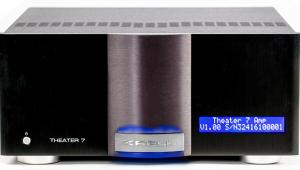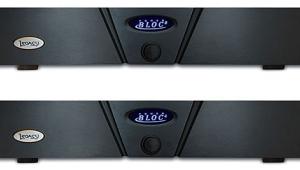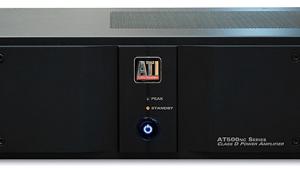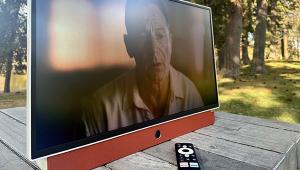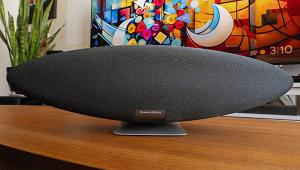Manley Snapper monoblock tube power amplifier
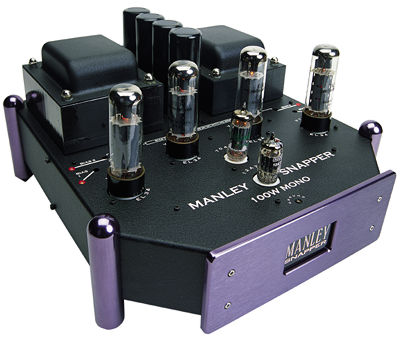
Manley Labs is as singular as their monoblock amplifier. In an industry populated primarily by men, this firm, owned and managed by a woman, is an anomaly. EveAnna Manley not only owns Manley Labs, she is also one of its designers and production engineers. But Manley stands out not just because of its owner's gender, but for its focus as well. The firm primarily makes gear for professional recording purposes. Their tube-based microphone preamps, limiters, equalizers, line preamps, D/A converters, and power amps are fixtures in many A-list recording studios throughout the world. Home theater is not their main or even their secondary thing. Nevertheless, like Genelec, M&K, Bryston, and ATC—also manufacturers of primarily professional recording gear—Manley offers some components that can be used in a high-end home theater. Their new Snapper monoblock amplifier is such a product.
The Tackle Box
For years I've searched in vain for a tube power amplifier suitable for home-theater use. The problems with most tube amps stem from their insufficient power, disproportionate cost per channel, excessive heat, and necessary periodic adjustments. The Manley Snapper is the first tube power amp I've seen that overcomes most of these shortcomings. With a rated output of 100W into 5ohms, it's still shy of the minimum THX specification of 120W, but a 100W tube amplifier is a far beefier beast than a 100W solid-state device.
At only $2125 each, the Snapper is comparable in price with many of the top-shelf solid-state multichannel amps SGHT has reviewed recently. Its four EL34 power tubes generate a certain amount of heat, but the amp's layout gives them enough breathing room to guarantee sufficient ventilation in all but the most congested environments. And even though, like all tube amplifiers, the Snapper needs periodic biasing of its power tubes, the procedure is simple enough that you can do it in minutes.
But what's up with the name? "Snapper" might conjure up an image of sparks, rude sounds, and a giant puff of smoke among the Guide's more tube-phobic readers, but fisher folk in the audience will immediately recognize the snapper as a variety of fish. All new Manley hi-fi products are named after fish. They have a Steelhead, a Stingray, and a Shrimp, so the Snapper fits right in. I just hope someone draws the line before we're subjected to a fuzzy-wuzzy brand of leopard-skin DLP projectors.
Traditional tube amps can look pretty boring. Most consist of black-anodized aluminum project boxes with tubes poking out. Fortunately, the Snapper has some style. Although its basic shape is rectangular, two of its front corners have been lopped off to make the front face an abbreviated plane. The metallic-blue faceplate features a 1¼ by 2½-inch backlit, inset panel that reads "manley snapper." Each of the Snapper's corners sports a 1-inch-thick metallic-blue dowel that serves as a spiked foot, raising the unit's bottom plate about 1½ inches. Not only does this improve the ventilation, but the dowels break up the cabinet's square edges. Another nice touch was setting the upper half of the Snapper's rear panel at a 45° angle to make the inputs and outputs easier to connect. Because of its small shape and size, it's hard to believe the Snapper weighs 39 pounds; most of that tonnage is accounted for by two beefy black transformers.
The Manley goal is to make a great-sounding but modern tube power amplifier by taking advantage of contemporary technologies. Unlike many tube amps currently made, which are merely older designs beefed up with high-performance audiophile parts, the Snapper has lots of high-performance parts and is an entirely new and original design from the brain of Manley's Mitch Margolis.
The Snapper's simple yet sophisticated circuit comprises six tubes. A 12AT7 serves as the input tube, while a 7044 acts as the voltage driver. Four EL34 tubes operating in ultralinear mode supply the output power. The entire amplifier employs a fully balanced differential topology, which is not uncommon in solid-state amplifiers, but it's rare in tube amplifiers. The negative speaker terminal is not the ground, as is commonly seen; it truly is a negative-phased counterpart to the positive output terminal. This differential circuit improves linearity compared with a conventional tube amp. Manley Labs designs and builds their own audio transformers, and the Snapper features a brand-new, 19-section output transformer. The power supply uses four 1300µF, 350VDC computer-grade capacitors, which hold 180 joules of energy storage for the B+ rail.
All in all, the Snapper is not your granddad's tube amplifier.
Rigging Up
Installing the Snapper monoblocks required no more effort than setting up a solid-state power amp. Unlike most tube amps, the Snapper includes both single-ended RCA and balanced XLR inputs. A small toggle switch on the chassis lets you select between them, while another selects between 15kohms or 600ohms input impedance for the XLR input. In my system, the three front-channel amps received balanced XLR inputs while the two rear amps got single-ended RCA connections.
After I'd hooked up speaker wires to the large, gold-plated, five-way WBT binding posts, all that was left was to turn on my A/V preamp and switch on the Snappers. After about 30 seconds, the Snappers' front panels began to glow and the amps were ready for duty. EveAnna Manley's lighthearted and well-written instruction manual recommends allowing the Snappers to warm up for about 45 minutes before commencing serious listening, and even offers suggestions for appropriate music choices during the warmup period. Anyone fancy "You Light Up My Life"?
Tubes glow. In some home-theater installations, the extra ambient light generated by five amplifiers' radiant filaments might be slightly more than ideal. Of course, in many home theaters, the amplifiers are hidden in sliding racks or behind removable screens, but if your amps are out in the open, the Snappers may just put out too much light. Although the Snapper doesn't normally come with any kind of tube cage or screen, which can substantially reduce the amount of light spilled from the tubes, Manley can supply screens for $100 each. My cats were smart enough to stay away, but if your house is populated by young children or inquisitive pets, you'll want to order a set of screens or cages for their protection.
After 45 minutes' warmup, the Snappers should be ready for anything you can throw at them. During the two-month review period, none of the five amps misbehaved in any way: In both of my HT systems, the Snappers were as stable and reliable as any comparably priced solid-state amp. They were also as physically quiet at the end of the review period as they were when first plugged in.
- Log in or register to post comments






